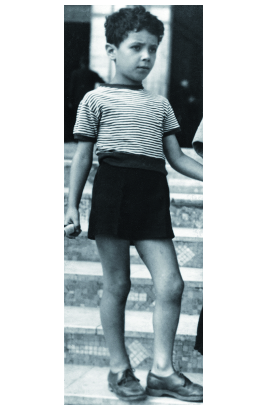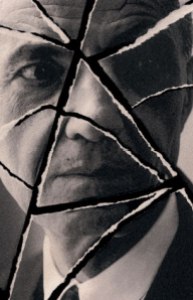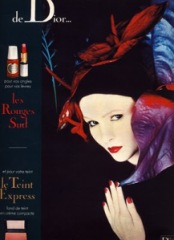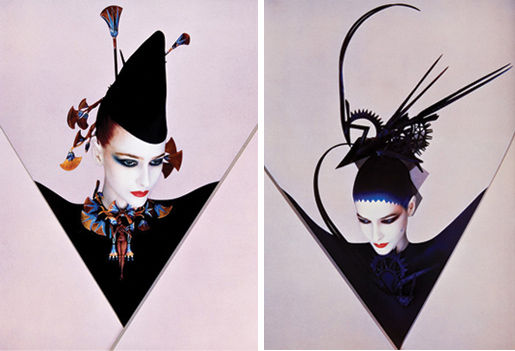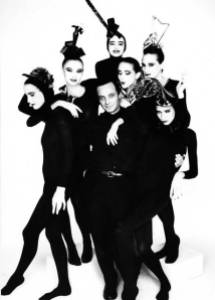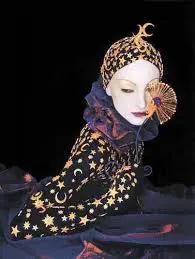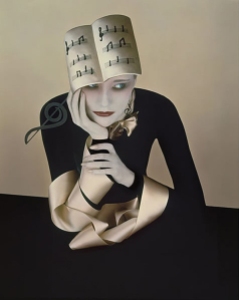A lonely man, born in war, unwanted by many in his family from the time of his birth, whose very existence was considered to be “a problem” and who later went on to revolutionize the worlds of fashion, beauty, photography, and perfumery. It is the story of a visionary called Serge Lutens.

“Solitude has hard teeth.” – Serge Lutens. Photo taken in Morocco by Ling Fei. Source: Le Monde Magazine. http://www.lemonde.fr/style/portfolio/2012/05/11/la-vie-en-images-de-serge-lutens_1699467_1575563.html
He may be the darling of the perfume world now, just as he was once the rising young star in both the fashion and beauty industry, but Serge Lutens’ origins are shrouded in some mystery. It is surprising, for even though he is, by all accounts, an intensely private man, he is also an incredibly famous one. In fact, his accomplishments from the 1980s to today are so well known that I found it unusual that there was rarely much talk about his early years or his background, especially on a personal level.
His official biography on the Lutens website wasn’t much help in terms of such details, so I was utterly stunned to find an article, tucked away in the absolute bowels of the site, in which Monsieur Lutens talked about his childhood and his family. The article is entitled “Serge Lutens: Conversation” by Pierre Lescure for the RM Exhibition in France (hereinafter referred to just as the “Lescure article“), and it explains so much about the man who we know and love today as “Uncle Serge.” That Lescure piece was the impetus for me to dig deeper into the famous legend, his past, and what drives him.
I ended up discovering more than I had expected, including the extent of his difficult childhood, the scars he bears, his genius and his accomplishments, but also many things about his philosophy to perfumery. So, this will be a two-part series with Part I focusing on Serge Lutens’ background and biography: his childhood, early years, and the events that have shaped him. Part II will focus on perfumery and his philosophy towards it. It will cover such things as, for example, his views on whether perfumes are aphrodisiacs, what he thinks about fragrances being unisex, and how his creations are, ultimately, the search for his own identity.
I’ve always been a die-hard admirer of Serge Lutens, but I was rather awed by all I learnt, as well as a little heartbroken for him. I hope you enjoy the story of the solitary visionary who brushed off his painful origins and persevered like a triumphant Sisyphus to take the worlds of beauty, art, photography, and perfumery by storm, before transforming them all forever.
THE MAN & HIS LIFE:
Serge Lutens was born during WWII, on March 14th, 1942 in Lille, in northern France. He was not wanted, at least not by his father or his grandparents. In fact, it seems the tiny baby was born from adultery which is something that makes absolutely no difference today, but it did back then, especially in Pétain’s Vichy France where women (but not men) could be severely punished under the law. In the Lescure article, Serge Lutens’ painful childhood is laid bare — and it’s not easy to read:
Serge Lutens was wanted by his mother. But she was the only one who wanted him. His father didn’t want her to keep the baby. The grandparents wanted nothing to do with “this woman” for their son. But she stood her ground, despite Serge’s father, despite a new husband, despite Pétain’s law that targeted women for adultery. A courageous mother, liberated in fact, despite her lowly station in life, despite everything.
Soon after his birth, at just a few weeks of age, baby Serge was removed from his mother, and put into what would be the first of several foster care homes. That fact is borne out not only by the official biography on the Lutens website, but also by a 2013 interview with the British newspaper, The Independent, entitled “Master perfumer Serge Lutens: ‘I don’t want to be recognised or famous‘.”
There, the famously shy Lutens opens up a little about his difficult childhood and how “the lack of a maternal figure had a profound effect on him.”
“I was born in the midst of the Second World War,” he says. “At the time, my mother was married and it was a complex situation. She was unfaithful to her husband.”
“My dad is not German,” he jokes. “Let me just be clear about that. But my mum had to give me up because if she hadn’t, the laws at the time meant she would have been punished as an adulteress. She did it in order to protect me and protect herself. My mum didn’t abandon me, but it means that I didn’t see her that much and I didn’t have a motherly character in my life. My personality was influenced by that.”
Lutens has spoken previously of his “blurred identity”, partly influenced by his illegitimacy. It is a subject that he has only spoken of in a veiled way before, but in person he shrugs it off. “It’s just a normal story,” he says. “All these things are seen through the light of your own experience.”
“All my life I went from one foster family to another, and this great instability provided a great opportunity for me to be able to work on myself, to write life in a way that wasn’t planned originally.”
Despite being constantly shuttled around, and the loss of a real home or mother figure, it would seem that the very young Lutens did see his mother on occasion as a toddler. According to, the Lescure interview with Monsieur Lutens, it might have been more of an on-and-off-again thing in the early years, perhaps due to a mother’s natural fear for her baby during the terrifying time of war and Nazi occupation.
At the very least, he saw her on one occasion in 1943, in an incident he recounted to Pierre Lescure and whose painful, traumatic memories have even been rendered concrete in the architectural structure of his Paris headquarters today:
At the center of the boutique gallery, anchored in the floor, at the heart of the Royal Palace, is a massive spiral stairway that seems to spin into infinity. It takes us up to the floor. The deep, intimate, violent and artistic relationship Serge Lutens had with his mother was forced in a stairwell in Northern France in 1943 under a Nazi bombardment. “There was a warning siren. I can still see my mother’s empty eyes — empty of everything but fear. For me and for herself. We go down to a bomb shelter. I’m very small, but the memory is very precise. Everyone squeezes together. And I literally lose my mother. I am squashed by grownups. At the all-clear, I see myself being jostled and bumped, climbing this interminable rusty staircase, hanging onto the honeycomb-like surface of each step. We found each other, but the terrifying vertigo of the stairway for me is the loss of my mother.
Serge Lutens may have been only a year old or 18-months at the time of that event in 1943, but it clearly left a mark. (For those of you who wonder about how a child so young may have such a detailed memory of an incident, there are apparently some studies from child psychologists and neurologists on “event memory,” which claim that toddlers can indeed recall deep trauma, even if they can’t verbalize it at the time. I’m am wholly unqualified to speak on either issue, and am merely quoting Lutens’ comments to the interviewer.)
Whatever the precise nature of his memories, I think the issue of his mother is the key to understanding Serge Lutens. As the Lescure article makes clear, it is the context for everything that drives him:
Serge Lutens’s discoveries since the early 60’s have become historic land-marks in womens’ beauty and womens’ lives. “In this woman’s life,” Serge insists. He hates when you talk about women. That says it all. For him, it’s “this woman,” his own double, whom he reinvents in every photograph, dress, makeup, makeup design, or perfume.
And “this woman” is really just his mother. As Pierre Lescure emphasizes throughout the article, Serge Lutens’ mother is his ultimate muse and source of creativity. He is never far from her, mentally and emotionally, and has always sought to keep her near. In a moment of philosophical and Freudian symbolism, Monsieur Lutens told the journalist, “I invented her so I could exist.” She is the one whom he is ultimately and symbolically always capturing — regardless of medium, whether it is photography, makeup, fashion, or perfumery. Thus, he, “whom his father always more or less intentionally melded with his mother” has now explicitly and defiantly melded himself with her.
According to Lescure, “[t]hese fragile beginnings, the solitary path, the double life, he and she makes him a sort of anti-Lagerfeld.” Which may explain, in part, why the fashion visionary to whom Lutens feels most connected is Yves St. Laurent. “Like Yves, Lutens ‘started as a problem.'” And like St. Laurent, Lutens worked incredibly hard from an extremely young age to start on his road to success.
In 1956, at the age of 14, Lutens was sent off to work “at a bourgeois hair salon in [Lille, in] northern France.” He hated it. The official biography on his website states,
he was given a job against his will – he would have preferred being an actor – in a beauty salon in his native city.
Two years later, he had already established the feminine hallmarks that he would make his own: eye shadow, ethereally beautiful skin, short hair plastered down. He also became known for the colour black, from which he never deviated. He confirmed his tastes and his choices with the female friends of his whom he photographed.
There, in that beauty salon, the teenage apprentice hair-dresser absorbed everything like a sponge, and took photographs all the while. To quote from the Lescure piece:
He observes authentic versus fake elegance, learns how to do everything, and how to adapt everything. Like an extension of his arm and his eye, his simple little camera is always with him.
War, unfortunately, had not finished with Serge Lutens. This was France in the late 1950s, after all, and the Algerian war was raging on. It was a conflict which I studied quite a bit at one time, and you cannot begin to imagine its impact on France. It was a war that threatened to ignite the country into a civil war, and there was almost a military coup which sought to topple the French government. Like all young men, Serge Lutens was subject to national military service; in 1960, at the age of 18, he was called up. The crucible of violence had its impact, and when his one-year period of conscription was over, Serge Lutens decided to forever change his life. Around 1961 or so, he left his hometown of Lille, and made his way to Paris.
Helped by a friend, and carrying large photos that he had taken with his tiny camera, Serge Lutens sought to make it big in the capitol. It wasn’t easy at first; the official bio on his website states, elliptically and obliquely, that he experienced a time of “insecurity and need.” Then, in 1962, at the age of 20, he contacted Vogue. “For him, this magazine represented the essence of beauty: a sort of convent that he mythologised.” And, thanks to those photos and his little Instamatic that he had taken everywhere with him while working as a teenager in Lille, he got the attention of Vogue’s legendary Editor-in-Chief, Edmonde Charles Roux. To quote from the Lescure piece:
His Instamatic would wind up opening some of the very best doors. He comes to Paris in ’62. He is 20. He brings his photographs to the great Edmond [sic] Charles Roux’s Vogue, at Place du Palais Bourbon. At Elle, the […] very young Lutens would be called upon whenever there was an emergency: a photo, the perfect jewelry to complete a shoot, the Christmas edition going to press in 3 days… Quick, quick, Serge, we need an idea! The man in black would become indispensable.
A 2012 article on the Lutens’ website entitled Mysteries of Beauty by Karim Moucharik for Dalia Air Magazine elaborates further:
At the age of 20, he entered French Vogue – whose editor-in-chief was then academician Edmonde Charles- Roux – with a portfolio in hand. He contributed to it as a photographer, along with great names like Guy Bourdin, Richard Avedon or Helmut Newton.
Actually, the young Lutens was such an instant star, that he worked with everyone, not just Vogue. All the magazines came calling, from Elle to Jardin des Modes and Harper’s Bazaar. He collaborated with the most famous photographers, while also pursuing his own art. It wasn’t just Richard Avedon, Guy Bourdin, or Helmut Newton, but also Bob Richardson, the great Irving Penn, and every other photo legend.
Serge Lutens wasn’t done yet. There were new worlds to conquer, and he did so when Christian Dior came calling. It was 1968, and though Serge Lutens was very young, his genius and versatility were clear to all. So, when one of the most prestigious fashion houses of all time decided that they wanted to expand into a new venture called “make-up,” they entrusted it to a 26-year old photographer and hairdresser.
Yes, it is Serge Lutens who is responsible for the invention of fashion house “makeup” as we know it today. He had already created such a buzz that, as the Lescure article makes clear, Dior and the legendary Mark Bohan turned over their entire plan “to ‘create’ make-up,” along with the development of an entire range of products, to Paris’ young, new star. Ironically, despite his love of black and his insistence on wearing nothing but black like his other heroes, Chanel and St. Laurent, Lutens would be most successful in white. According to the Lescure piece, it was the use of that unexpected colour in makeup which made the Lutens line so revolutionary. The result was a blockbuster hit, for the both of them, and a life of “Travel, luxury, airplanes, Rolls-Royces.”
In the 1970s, Lutens continued his meteoric rise. The famous editor-in-chief of American Vogue, Diana Vreeland, was unstinting in her enthusiasm and put his face on Vogue’s cover with the headline: “Serge Lutens, Revolution of Make-up!” To quote his official bio on the Lutens website, “His success was resounding. Serge Lutens became the symbol of the freedom created through makeup, for a whole new generation.”
It still wasn’t enough. Lutens started to explore different artistic ventures, and succeeded brilliantly each and every time. In 1972, according to Wikipedia, his series of photographs (inspired by such famous painters as Claude Monet, Georges-Pierre Seurat, Pablo Picasso and Amedeo Modigliani) was impressive enough to be shown at the prestigious Guggenheim Museum in New York. In 1974, he made several short films based on his passion for movies and the legendary actresses in them. They were good enough to get shown at the famous Cannes Films Festival.

Serge Lutens 1971. Source: Serge Lutens Archives, via Le Monde style magazine. http://tinyurl.com/qj2hke6
During this time, he also travelled widely, especially to Morocco and Japan, two countries whose very different cultures would impact him enormously in years to come.
The 1980s mark the start of the period in Lutens’ life which most people know about today. It was the beginning of his Shiseido era. As his official biography explains:
in 1980, […] he signed on with Shiseido for a collaboration that was to enable the Japanese cosmetics group, until then unknown on the international scene, to establish such a powerful visual identity that it became one of the world’s leading market players in the 1980’s and ‘90’s.
Lutens created makeup for the company, designed its packaging, took photographs, and sought to reinvented Shiseido’s entire image, while also expanding their business into foreign markets. It is all thanks to Serge Lutens that Shiseido, today, is a market force and beauty giant. However, his success wasn’t limited just to beauty, marketing, and business development. Throughout the 1980s, he also shot various advertising campaigns and films for Shiseido. He was so brilliant, he won two ‘Lions d’Or‘ at the International Advertising Film Festival.
All these conquered worlds, but it still wasn’t enough for the versatile, seemingly restless genius. Lutens now decided to venture out to explore a totally new area of beauty and art: perfume. He became Shiseido’s Master-Perfumer, and released their first fragrance. Everyone has heard about his famous 1992 creation, Feminité du Bois, for the company, but what some people don’t realise is that the very first Lutens fragrance actually came a whole decade earlier. To quote his website biography, in 1982, “he conceived Nombre Noir, his first perfume, dressed in lustrous black on matte black, a concept that foreshadowed the ubiquitous codes of the 1990’s.”
Nombre Noir was a masterpiece, according to all who spoke about it to the Independent for their Lutens profile (linked up above):
[It] “burnt a hole into everyone’s collective memory”, according to Chandler Burr, former New York Times perfume critic, in his book The Emperor of Scent, which chronicles the work of ‘nose’ Luca Turin. Turin, for his part, classifies Nombre Noir “just too wonderful for words, one of the five great perfumes of the world”. No longer in production, but still a favourite among fragrance-lovers, a 60ml bottle is listed on eBay for $999 (£614) at the time of writing.
 In 1992, Serge Lutens established his perfume headquarters at Les Salons du Palais Royal, but he was still working under Shiseido’s umbrella. Then, in 2000, with Shiseido’s financial backing and blessing, he went independent and launched his own, eponymous, niche brand. In all cases, however, whether it was perfume for Shiseido or creations for his own house, the effect was the same: he revolutionized the field of perfumery just as he had done decades before in beauty. By 2007, the range, depth, and impact of his decades-long work across various artistic platforms resulted in Serge Lutens being awarded the title “Commandeur des Arts et Lettres” by the French government.
In 1992, Serge Lutens established his perfume headquarters at Les Salons du Palais Royal, but he was still working under Shiseido’s umbrella. Then, in 2000, with Shiseido’s financial backing and blessing, he went independent and launched his own, eponymous, niche brand. In all cases, however, whether it was perfume for Shiseido or creations for his own house, the effect was the same: he revolutionized the field of perfumery just as he had done decades before in beauty. By 2007, the range, depth, and impact of his decades-long work across various artistic platforms resulted in Serge Lutens being awarded the title “Commandeur des Arts et Lettres” by the French government.
 No matter which world he conquered, the emotional truth seems to be that he did so not for all women (plural), but always just for “‘this woman‘.” According to Pierre Lescure, Serge Lutens hates it when people talk about “women’s lives,” and corrects them to talk about “this” woman, singular. And that abstract, unnamed, representative, singular woman really seems to be one, very real, flesh-and-blood woman: his mother. Everything he has done seems to be in homage to her, in an attempt to symbolically meld himself, through different artistic mediums, to the one woman from whose arms he was ripped away in infancy. It is all for her, a woman “of great silences” who told him at some unstated, undetermined time: “‘Now it’s your turn. You must go on without me.'”
No matter which world he conquered, the emotional truth seems to be that he did so not for all women (plural), but always just for “‘this woman‘.” According to Pierre Lescure, Serge Lutens hates it when people talk about “women’s lives,” and corrects them to talk about “this” woman, singular. And that abstract, unnamed, representative, singular woman really seems to be one, very real, flesh-and-blood woman: his mother. Everything he has done seems to be in homage to her, in an attempt to symbolically meld himself, through different artistic mediums, to the one woman from whose arms he was ripped away in infancy. It is all for her, a woman “of great silences” who told him at some unstated, undetermined time: “‘Now it’s your turn. You must go on without me.'”
I’m not a psychologist, but it’s hard to escape the feeling that Freud would have had a field day by Serge Lutens’ symbolic attempts to return to his mother’s womb through the exploration of every possible artistic medium concerning women. Even that great spiral staircase in Les Palais Royale has Freudian meaning, particularly in light of Serge Lutens’ stairwell trauma that night back in 1943. Please don’t think I’m making judgments; I am not. We all bear childhood scars, but some of us have suffered more than others. And, frankly, my heart goes out to Monsieur Lutens for what clearly seems to be an emotionally devastating childhood.
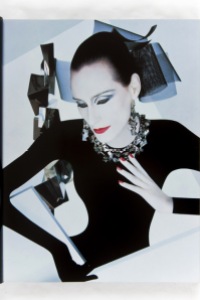 Whatever the past or the source of his inspiration, there is no doubt that Serge Lutens’ artistic homage to the famous abstract “woman,” singular, results in work that is absolutely stunning. From the Shiseido ads of the 1990s that reference modern art (and Dada-ism), to his stylistic endeavours and marketing, he has a style that is incredibly powerful, eye-catching and provocative. Take a look, for example, at some of his work in the 2012 Dalia Air Magazine piece hidden in the bowels of the Lutens website, the photos shown on the website of the French newspaper, Le Monde, or any of the Shiseido ads easily found on the web:
Whatever the past or the source of his inspiration, there is no doubt that Serge Lutens’ artistic homage to the famous abstract “woman,” singular, results in work that is absolutely stunning. From the Shiseido ads of the 1990s that reference modern art (and Dada-ism), to his stylistic endeavours and marketing, he has a style that is incredibly powerful, eye-catching and provocative. Take a look, for example, at some of his work in the 2012 Dalia Air Magazine piece hidden in the bowels of the Lutens website, the photos shown on the website of the French newspaper, Le Monde, or any of the Shiseido ads easily found on the web:
CONCLUSION:
We are all shaped by our past and, as Thomas Hardy once wrote in Tess of the d’Urbervilles, “experience is as to intensity and not as to duration.” Serge Lutens began his life in war and emotional trauma, but he used those experiences as a wellspring from which to draw strength and to overcome all obstacles. A prodigy and genius, he took the beauty and fashion world by storm, changing their face forever, before eventually setting his sights on the world of perfumery. In Part II, we will explore that world and his fragrance philosophy.

